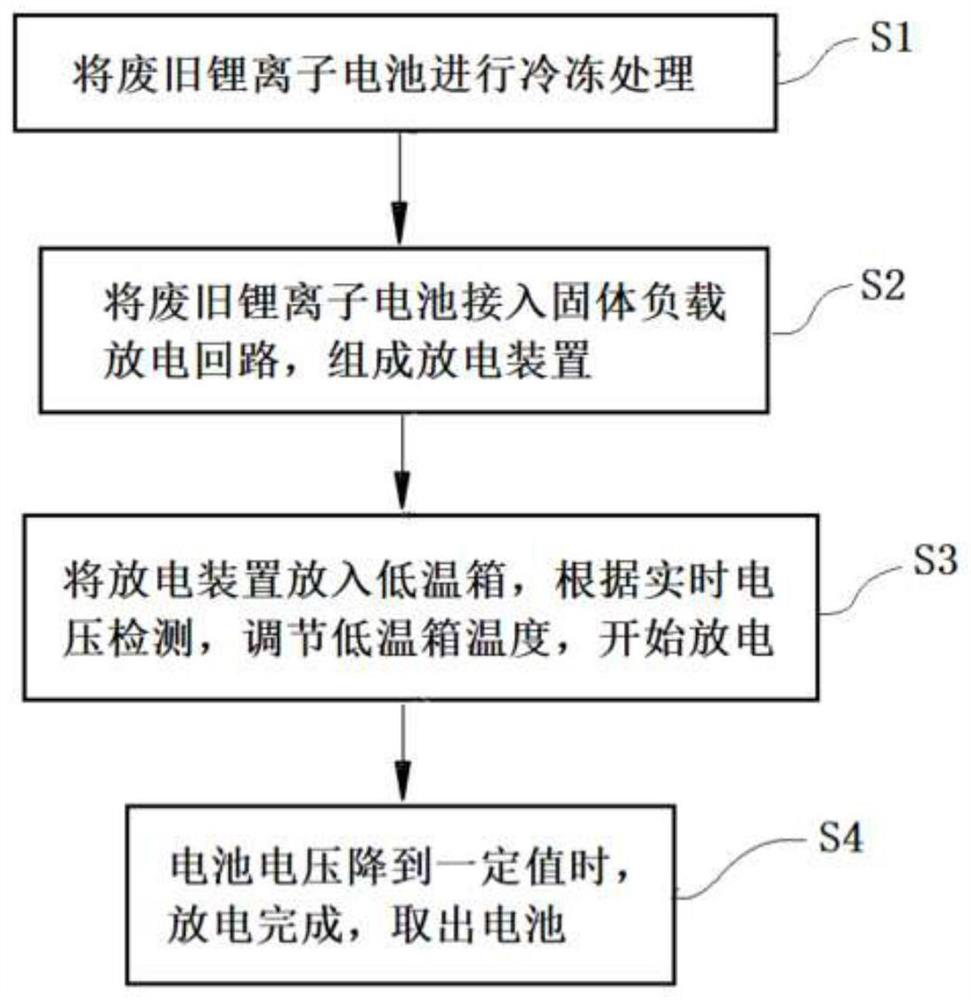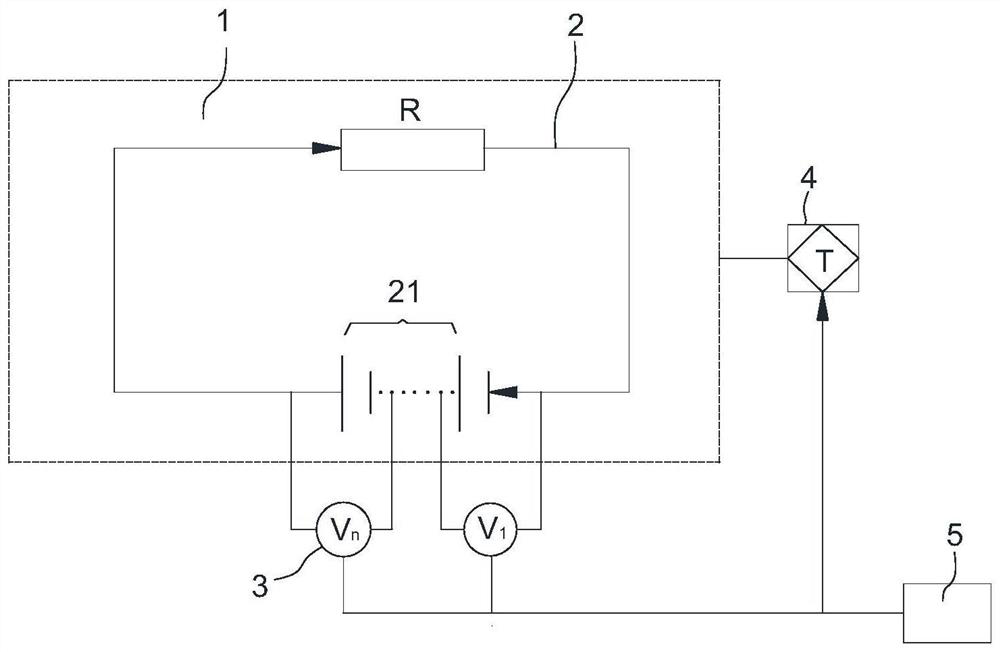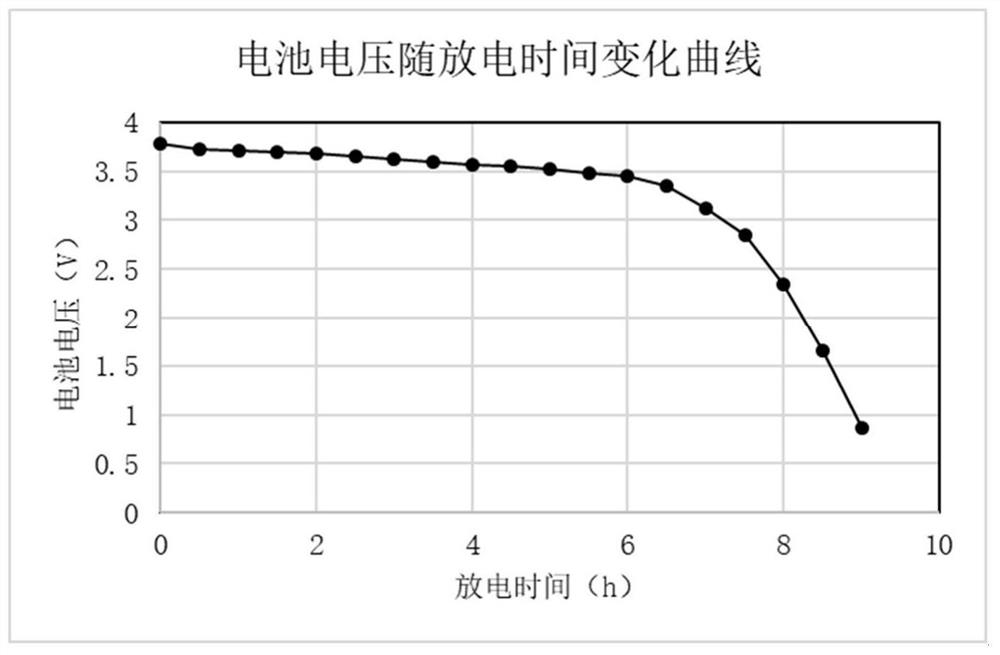Safe discharging method for waste lithium ion battery
A lithium-ion battery, battery voltage technology, applied in the direction of secondary battery charging/discharging, secondary battery, battery recycling, etc., can solve the problems of unguaranteed discharge efficiency, potential safety hazards, incomplete discharge, etc., to achieve low cost, Improve efficiency and safety, high-efficiency discharge effect
- Summary
- Abstract
- Description
- Claims
- Application Information
AI Technical Summary
Problems solved by technology
Method used
Image
Examples
Embodiment 1
[0039] S1 Treat a waste square aluminum shell ternary lithium-ion battery with an open circuit voltage of 3.78V in a liquid nitrogen freezing environment at -30°C for 10 minutes;
[0040] S2 Connect the frozen waste square aluminum shell ternary lithium-ion battery to a 1Ω resistance load discharge circuit, then connect the battery to a battery voltage detector to form a discharge device, and paste it on the surface of the waste square aluminum shell ternary lithium-ion battery shell The upper thermocouple is used to verify the change trend of the surface temperature of the waste square aluminum shell ternary lithium-ion battery;
[0041] S3 Immediately put the discharge device into the low-temperature box, connect it to the temperature controller, and connect the battery voltage detector, temperature controller and thermocouple to the main controller, set the temperature of the low-temperature box to 0°C, and after discharging for 6 hours, the battery voltage detection The de...
Embodiment 2
[0046] S1 Treat 4 waste lithium manganese oxide 18650 steel case lithium-ion batteries with an open circuit voltage of 3.65V in a liquid nitrogen cooling environment at -20°C for 15 minutes;
[0047] S2 Connect the frozen battery to a graphite powder discharge frame with a resistance of 5Ω, and then connect the battery to a battery voltage detector to form a discharge device;
[0048] S3 Put the discharge device into the low temperature box immediately, connect it to the temperature controller, and connect the battery voltage detector and the temperature controller to the main controller, set the temperature of the low temperature box to -5°C, and after discharging for 3 hours, the battery voltage detector detects When the battery voltage drops below 3.5V, adjust the temperature of the incubator to 30°C and continue discharging.
[0049] S4 After continuing to discharge for 2 hours, the battery voltage detector detects that the battery voltage drops below 1.0V, the discharge i...
Embodiment 3
[0051] S1 Process a waste lithium iron phosphate soft-packed lithium-ion battery with an open circuit voltage of 3.42V in a liquid nitrogen cooling environment at -10°C for 30 minutes;
[0052] S2 Connect the frozen battery to a resistance discharge circuit with a resistance of 3Ω, and then connect the battery to a battery voltage detector to form a discharge device;
[0053] S3 Put the discharge device into the low temperature box immediately, connect the battery voltage detector and thermocouple to the main controller, set the temperature of the low temperature box to 0°C, and after 4 hours of discharge, it is detected that the battery voltage drops below 3.2V, and the temperature of the low temperature box is adjusted to 35°C, continue to discharge.
[0054] S4 After continuing to discharge for 2 hours, the battery voltage detector detects that the battery voltage drops below 1.0V, the discharge is completed, and the battery is taken out.
PUM
| Property | Measurement | Unit |
|---|---|---|
| electrical resistance | aaaaa | aaaaa |
Abstract
Description
Claims
Application Information
 Login to View More
Login to View More - R&D
- Intellectual Property
- Life Sciences
- Materials
- Tech Scout
- Unparalleled Data Quality
- Higher Quality Content
- 60% Fewer Hallucinations
Browse by: Latest US Patents, China's latest patents, Technical Efficacy Thesaurus, Application Domain, Technology Topic, Popular Technical Reports.
© 2025 PatSnap. All rights reserved.Legal|Privacy policy|Modern Slavery Act Transparency Statement|Sitemap|About US| Contact US: help@patsnap.com



